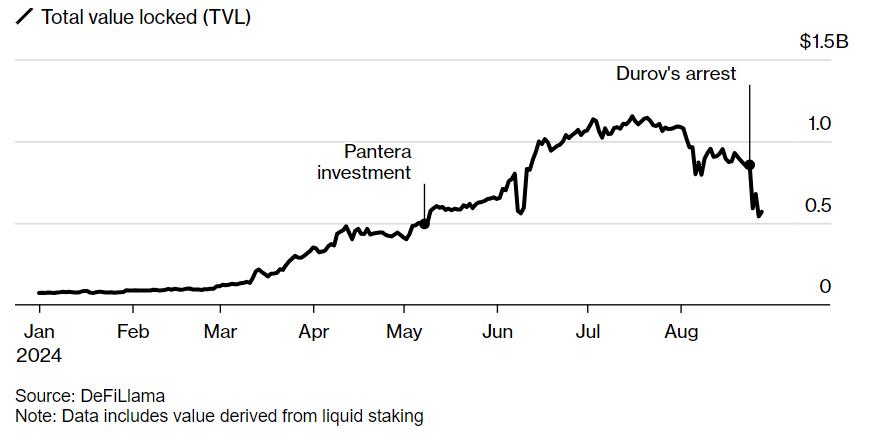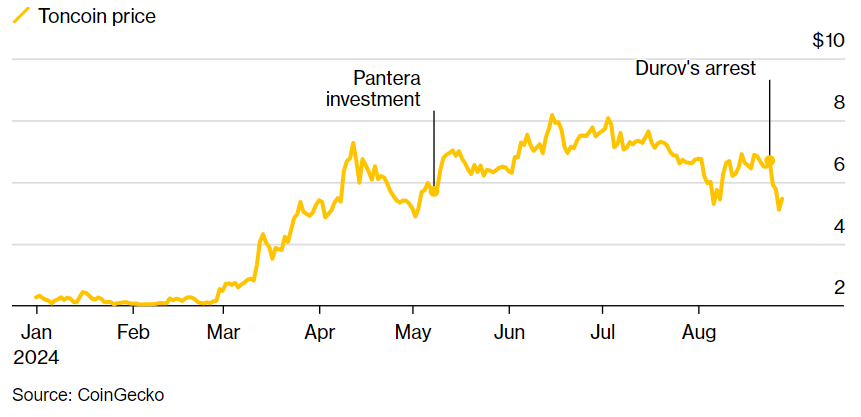The detention of Telegram founder Pavel Durov in France has caused a stir in the crypto venture capital sector, and some players in the field have invested in Toncoin, a digital token closely related to the messaging app.
Pantera Capital Management, Animoca Brands and Mirana Ventures are among more than a dozen institutions that have invested in Toncoin, whose blockchain is used by Telegram to process things like instant payments. Pantera, one of the largest crypto venture capital funds, invested more than $100 million in Toncoin earlier this year, people familiar with the matter said.
Attracting these funds is a fascinating crypto concept: Telegram will evolve into a digital asset "super app" similar to WeChat, with its 900 million users relying on Toncoin for everything from paying to playing blockchain games. From February to early July this year, the token soared fourfold, with TVL on its blockchain TON once exceeding $1 billion.
But Durov's detention on charges of not doing enough to combat crime on Telegram exposed its risks. Durov was accused on August 29 of participating in the distribution of child pornography and other crimes such as drug trafficking on the app. Telegram said in a statement that it complies with European law.
After Durov was arrested outside Paris on August 24, Toncoin plummeted by about 20%, and later regained some of its "lost ground." According to DefiLlama data, TON’s TVL has dropped to $573 million.
Usage drops

Lasse Clausen, founder of crypto venture capital firm 1kx, said:
Most investors believe that the app itself will greatly facilitate and drive adoption of the Toncoin network.
What is happening now is that a black swan event has happened to the company itself and its founder, which may raise some questions about the future.
Venture capitalists who have poured money into Toncoin, often with agreements not to sell the tokens for at least a year, are now trying to assess whether France's move against Durov will cause users to flee Telegram. The app is popular in crypto circles, largely due to its ultra-lax regulatory approach, which has landed him in legal trouble.
Pantera said Toncoin is its largest investment, but did not disclose the specific amount. The TON Foundation, which manages the blockchain, said in an email that it has never raised funds. Animoca Brands did not comment on its investment, and Mirana Ventures did not immediately respond to inquiries.
Some Toncoin backers saw an "opportunity." Eugene Ng, co-founder of DWF Labs, said that DWF Labs, a crypto market maker that invested in the token, spent "millions" of dollars buying Toncoin on the open market after Toncoin's price plummeted.
Token trading, liquidity
OTC investments by venture capital firms and other crypto funds in projects such as TON are called "token transactions" because investors receive tokens instead of traditional stocks. To achieve these goals, venture investors often set up separate vehicles called liquid funds, which are designed to hold assets for shorter periods of time. Since many token trades occur one-on-one over the counter, there aren't any reliable estimates of a token's popularity.
Tokens have several advantages for VCs and their investors, the most obvious being that tokens tend to involve faster exits. A common structure is for tokens to begin unlocking after 12 months, after which investors can gradually sell them. Lasse Clausen, founder of 1kx, said that the fluctuation of tokens also allows supporters to have a more comprehensive understanding of the progress of the project.
Token transactions may also involve significant discounts. Pantera acquired Toncoin at a price that was 40% below the market price, said a person familiar with the matter who asked not to be named because the terms of the transaction are confidential.
At an average price of $6.32 when the deal was announced in May, the investment is still profitable.

The person familiar with the matter said that Pantera’s lock-up period is one year, after which Toncoin can be sold in batches over several years.
Another aspect of token investing is that the assets are extremely volatile: if something goes wrong with the investment, it becomes apparent immediately. Funds typically mark-to-market their holdings on a regular basis, meaning significant price drops are immediately reflected in reports to limited partners.
Nothing illustrates this risk better than the collapse of Do Kwon’s TerraUSD stablecoin project in May 2022. Just a few months ago, investors including Three Arrows Capital and Jump Crypto purchased over $1 billion in Luna, a token used to stabilize TerraUSD. When TerraUSD collapsed, Luna became worthless. Soon after, Three Arrows went bankrupt, triggering a series of collapses across the crypto industry.
 Why was Durov arrested and what impact will it have on the TON ecosystem?
Why was Durov arrested and what impact will it have on the TON ecosystem?



 Related reports
Related reports



